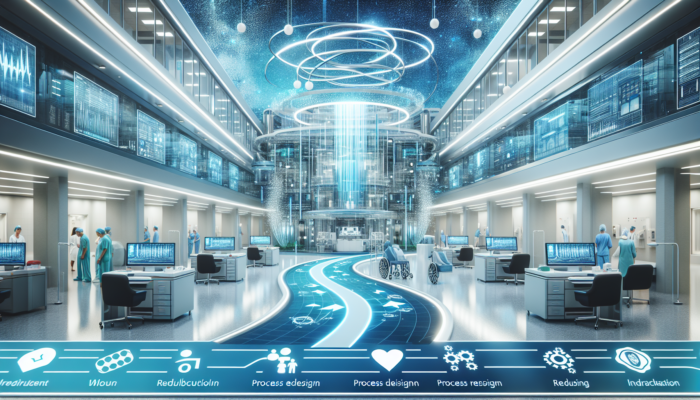Process Redesign: Driving Automation Efficiency in Healthcare
In the contemporary, fast-paced landscape, both efficiency and automation are pivotal elements that underpin the effective operation of various industries, with healthcare being no exception. As the demand for high-quality healthcare services continues to escalate, medical organisations are diligently exploring methods to streamline their processes and enhance patient care outcomes. This is precisely where process redesign and automation become indispensable, playing a strategic role in transforming healthcare delivery.
Understanding the Critical Importance of Efficiency in Healthcare
The landscape of healthcare organisations is fraught with numerous challenges, ranging from escalating costs and surging patient volumes to constrained resources. Within such a multifaceted environment, it becomes essential to optimise processes to guarantee that patients receive prompt and high-quality care. The optimisation of workflows not only enhances efficiency but also contributes significantly to better health outcomes.
Process redesign entails a comprehensive reevaluation and reengineering of existing workflows to remove unnecessary steps, diminish errors, and boost overall efficiency. By embracing process redesign in the healthcare sector, organisations can effectively reduce waste, alleviate bottlenecks, and significantly improve patient satisfaction, ultimately leading to a more agile and responsive healthcare system.
Discovering the Transformative Benefits of Process Redesign in Healthcare

-
Enhanced Patient Safety: A primary objective of process redesign is to enhance patient safety. By systematically removing redundant steps, standardising operations, and instituting error-prevention mechanisms, healthcare organisations can significantly lower the incidence of medical errors and adverse events. This comprehensive approach ensures that patients receive the appropriate care at precisely the right time, thereby minimising potential harm and fostering a safer healthcare environment.
-
Boosting Patient Satisfaction: Streamlining processes within healthcare organisations can lead to decreased waiting times, improved communication, and an enriched overall patient experience. This can be accomplished through the implementation of advanced technologies such as self-check-in kiosks, electronic medical record systems, and automated appointment reminders. Furthermore, improved coordination between healthcare providers and various departments facilitates smoother transitions of care, ultimately leading to enhanced patient satisfaction.
-
Cost Reduction: Process redesign empowers healthcare organisations to identify and eliminate non-value-added activities, resulting in substantial cost savings. Through the optimisation of resource utilisation and waste reduction, organisations can allocate their resources more effectively and efficiently. For instance, automation can significantly streamline administrative tasks, such as billing and claims processing, minimising the need for manual intervention and reducing costs associated with human error.
-
Boosted Staff Productivity: By streamlining processes and alleviating administrative burdens, healthcare professionals can dedicate more time to direct patient care. The automation of routine tasks and the elimination of manual paperwork enable staff to enhance patient interactions, leading to improved health outcomes. Additionally, automation can assist with critical tasks, including medication dispensing and inventory management, thereby allowing staff to focus on complex clinical decision-making.
-
Optimised Data Management: The implementation of process redesign often involves adopting automation and digitalisation strategies. This transition results in better data management, increased accuracy, and improved access to vital patient information. The availability of real-time data enables healthcare professionals to make informed decisions and deliver personalised care. Integration of electronic health records, clinical decision support systems, and data analytics tools further augments the quality and efficiency of healthcare delivery.
Harnessing the Power of Automation in Healthcare
Automation serves a crucial function in enhancing efficiency within the healthcare sector. By leveraging cutting-edge technology and sophisticated software solutions, healthcare organisations can automate repetitive and time-consuming tasks, ensuring precise and efficient operations. The advantages of automation in healthcare are manifold:
-
Minimising Human Errors: Automation significantly reduces the risk of human errors, such as transcription mistakes or data entry inaccuracies. By automating processes such as appointment scheduling or prescription filling, healthcare organisations can dramatically diminish the likelihood of errors. This advancement not only enhances patient safety but also mitigates the necessity for costly error corrections.
-
Streamlining Workflow: Automation optimises workflows by eliminating manual handoffs, decreasing paperwork, and automating data exchange across different systems. This leads to expedited processing times, reduced bottlenecks, and enhanced overall efficiency. For example, automated patient triage systems can prioritise and assign cases based on their severity, significantly improving workflow in emergency departments.
-
Facilitating Enhanced Communication: Automation enables seamless communication among healthcare professionals, departments, and patients. By automating notifications, reminders, and alerts, healthcare organisations can ensure timely communication, which fosters improved collaboration and coordination. This is particularly beneficial during care transitions, where automated alerts can help avert medication errors or prevent missed follow-up appointments.
-
Utilising Real-time Analytics: Automation empowers healthcare organisations to gather and analyse real-time data, providing invaluable insights for informed decision-making. This capability aids in identifying areas for improvement, optimising resource allocation, and enhancing patient care outcomes. For instance, automated data analytics tools can monitor patient outcomes and alert healthcare providers to potential complications, facilitating early interventions and better patient results.
-
Ensuring Compliance: Automation aids healthcare organisations in maintaining compliance with various regulatory requirements. By automating documentation processes and ensuring timely follow-ups, organisations can mitigate compliance risks and avoid penalties. For example, automated coding and billing systems guarantee accurate documentation and coding, thereby minimising the risk of non-compliance with coding guidelines and regulations.
Strategic Steps for Implementing Process Redesign and Automation in Healthcare
Implementing process redesign and automation within the healthcare sector necessitates meticulous planning and collaboration among diverse stakeholders. Below are essential steps to consider:
-
Identify Areas for Improvement: Conduct a comprehensive analysis of existing processes to pinpoint bottlenecks, inefficiencies, and areas ripe for automation. Involve healthcare professionals, administrators, and IT experts to gather insights and requirements. This may entail conducting time-motion studies, workflow analyses, and obtaining feedback from frontline staff.
-
Develop a Comprehensive Roadmap: Create a detailed plan outlining the necessary steps for implementing process redesign and automation. Define clear objectives, timelines, and resource requirements. Prioritise areas that exhibit the highest potential for improvement, considering factors such as cost, feasibility, and their impact on patient care outcomes.
-
Select Appropriate Technology: Evaluate various automation technologies and software solutions available in the marketplace. Consider factors such as scalability, flexibility, security, and integration capabilities. Choose a solution that aligns with your organisation’s goals and requirements, ensuring that the selected technology is user-friendly and easily adoptable by staff members.
-
Engage and Train Staff: Effective training is crucial for the successful implementation and acceptance of new processes and technologies. Educate staff on the benefits of process redesign and automation, provide hands-on training on new systems, and encourage their active participation in the change management process. This engagement can include conducting workshops, furnishing user manuals, and offering ongoing support and guidance.
-
Monitor and Evaluate Progress: Continuously track the performance of redesigned processes and automated systems. Gather feedback from staff and patients to identify additional areas for improvement. Regularly review key performance indicators to assess the impact of process redesign and automation on efficiency and patient outcomes. Make necessary adjustments and refinements based on the feedback received to ensure sustained improvement and effectiveness.
In summary, driving efficiency through process redesign and automation is essential in the healthcare industry. By adopting these innovative strategies, healthcare organisations can optimise processes, enhance patient safety and satisfaction, reduce costs, and improve overall healthcare delivery. The journey towards automation in healthcare entails careful planning, collaboration, and the selection of appropriate technology to ensure successful implementation and long-term benefits.
Note: The complete article is provided in markdown format below:
# Driving Efficiency: Process Redesign and the Path to Automation in Healthcare
In today's fast-paced world, efficiency and automation are key factors in ensuring the smooth functioning of any industry, and healthcare is no exception. As the demand for quality healthcare services continues to rise, healthcare organizations are constantly seeking ways to streamline their processes and improve patient care outcomes. This is where process redesign and automation play a crucial role.
The Need for Efficiency in Healthcare
 Healthcare organizations face numerous challenges on a daily basis, including rising costs, increasing patient volumes, and limited resources. In such a complex environment, it becomes imperative to optimize processes to ensure that patients receive timely and high-quality care.
Process redesign involves reevaluating and reengineering existing processes to eliminate unnecessary steps, reduce errors, and enhance overall efficiency. By implementing process redesign in healthcare, organizations can cut down on waste, minimize bottlenecks, and improve patient satisfaction.
Healthcare organizations face numerous challenges on a daily basis, including rising costs, increasing patient volumes, and limited resources. In such a complex environment, it becomes imperative to optimize processes to ensure that patients receive timely and high-quality care.
Process redesign involves reevaluating and reengineering existing processes to eliminate unnecessary steps, reduce errors, and enhance overall efficiency. By implementing process redesign in healthcare, organizations can cut down on waste, minimize bottlenecks, and improve patient satisfaction.
Key Benefits of Process Redesign in Healthcare
- Improved Patient Safety: One of the primary goals of process redesign is to enhance patient safety. By eliminating redundant steps, standardizing processes, and implementing error-prevention mechanisms, healthcare organizations can significantly reduce the risk of medical errors and adverse events. This ensures that patients receive the right care at the right time, minimizing potential harm.
- Enhanced Patient Satisfaction: By streamlining processes, healthcare organizations can reduce waiting times, improve communication, and enhance the overall patient experience. This can be achieved by implementing technologies such as self-check-in kiosks, electronic medical record systems, and automated appointment reminders. Additionally, improved coordination between healthcare providers and departments leads to smoother transitions of care and better patient satisfaction.
- Reduced Costs: Process redesign allows healthcare organizations to identify and eliminate non-value-added activities, leading to cost savings. By optimizing resource utilization and reducing waste, organizations can allocate their resources more efficiently and effectively. For example, automation can streamline administrative tasks like billing and claims processing, reducing the need for manual intervention and lowering costs associated with human error.
- Increased Staff Productivity: Streamlined processes and reduced administrative burdens enable healthcare professionals to focus more on direct patient care. By automating routine tasks and eliminating manual paperwork, staff can spend more time interacting with patients, leading to improved outcomes. Moreover, automation can assist in tasks like medication dispensing and inventory management, freeing up staff to concentrate on complex clinical decision-making.
- Enhanced Data Management: Process redesign often involves the implementation of automation and digitalization strategies. This allows for better data management, improved accuracy, and increased accessibility to vital patient information. The availability of real-time data enables healthcare professionals to make informed decisions and provide personalized care. Integration of electronic health records, clinical decision support systems, and data analytics tools can further enhance the quality and efficiency of healthcare delivery.
The Role of Automation in Healthcare
Automation plays a significant role in driving efficiency in healthcare. By leveraging technology and advanced software solutions, healthcare organizations can automate repetitive and time-consuming tasks, ensuring accurate and efficient operations. Automation offers several benefits in the healthcare industry:
- Reduced Human Errors: Automation minimizes the risk of human errors, such as transcription errors or data entry mistakes. By automating processes like appointment scheduling or prescription filling, healthcare organizations can significantly reduce the likelihood of mistakes. This improves patient safety and reduces the need for costly error correction.
- Improved Workflow: Automation streamlines workflows by eliminating manual handoffs, reducing paperwork, and automating data exchange between different systems. This leads to faster processing times, reduced bottlenecks, and improved overall efficiency. For example, automated patient triage systems can prioritize and assign cases based on severity, optimizing the workflow in emergency departments.
- Enhanced Communication: Automation facilitates seamless communication among healthcare professionals, departments, and patients. By automating notifications, reminders, and alerts, healthcare organizations can ensure timely communication, leading to improved collaboration and coordination. This can be particularly beneficial in care transitions, where automated alerts can help prevent medication errors or missed follow-up appointments.
- Real-time Analytics: Automation enables healthcare organizations to collect and analyze real-time data, providing valuable insights for decision-making. This helps in identifying areas for improvement, optimizing resource allocation, and enhancing patient care outcomes. For instance, automated data analytics tools can monitor patient outcomes and alert healthcare providers of potential complications, allowing for early interventions and improved patient outcomes.
- Improved Compliance: Automation helps healthcare organizations stay compliant with various regulatory requirements. By automating documentation processes and ensuring timely follow-ups, organizations can reduce compliance risks and avoid penalties. For example, automated coding and billing systems can ensure accurate documentation and coding, minimizing the risk of non-compliance with coding guidelines and regulations.
Implementing Process Redesign and Automation
 Implementing process redesign and automation in healthcare requires careful planning and collaboration among various stakeholders. Here are some steps to consider:
Implementing process redesign and automation in healthcare requires careful planning and collaboration among various stakeholders. Here are some steps to consider:
- Identify Areas for Improvement: Conduct a thorough analysis of existing processes to identify bottlenecks, inefficiencies, and areas that can benefit from automation. Engage healthcare professionals, administrators, and IT experts to gain insights and gather requirements. This can involve conducting time-motion studies, workflow analysis, and obtaining feedback from frontline staff.
- Develop a Roadmap: Create a detailed plan outlining the steps required to implement process redesign and automation. Define clear objectives, timelines, and resource requirements. Prioritize areas that offer the highest potential for improvement. Consider factors such as cost, feasibility, and impact on patient care outcomes.
- Select the Right Technology: Evaluate different automation technologies and software solutions available in the market. Consider factors such as scalability, flexibility, security, and integration capabilities. Choose a solution that aligns with your organization's goals and requirements. Ensure that the chosen technology is user-friendly and can be easily adopted by staff.
- Train and Engage Staff: Proper training is crucial to ensure the successful implementation and adoption of new processes and technologies. Train staff on the benefits of process redesign and automation, provide hands-on training on new systems, and encourage their active participation in the change management process. This can include conducting workshops, providing user manuals, and offering ongoing support and guidance.
- Monitor and Evaluate: Continuously monitor the performance of redesigned processes and automated systems. Collect feedback from staff and patients to identify areas for further improvement. Regularly review key performance indicators to measure the impact of process redesign and automation on efficiency and patient outcomes. Make necessary adjustments and refinements based on the feedback received to ensure sustained improvement.
In conclusion, driving efficiency through process redesign and automation is paramount in the healthcare industry. By embracing these strategies, healthcare organizations can optimize processes, enhance patient safety and satisfaction, reduce costs, and improve overall healthcare delivery. The path to automation in healthcare requires careful planning, collaboration, and the right technology to ensure successful implementation and long-term benefits.
Frequently Asked Questions About Process Redesign and Automation in Healthcare
1. What are the key benefits of process redesign in healthcare?
- Improved Patient Safety: By eliminating redundant steps and implementing error-prevention mechanisms, process redesign reduces the risk of medical errors and adverse events, ensuring patients receive the right care at the right time.
- Enhanced Patient Satisfaction: Streamlining processes reduces waiting times, improves communication, and enhances the overall patient experience, leading to better satisfaction.
- Reduced Costs: Process redesign identifies and eliminates non-value-added activities, optimizing resource utilization and reducing waste, resulting in cost savings.
- Increased Staff Productivity: By automating routine tasks and reducing administrative burdens, staff can spend more time interacting with patients and focusing on direct patient care.
2. What role does automation play in healthcare?
- Reduced Human Errors: Automation minimizes the risk of human errors by automating processes like appointment scheduling or prescription filling, improving patient safety.
- Improved Workflow: Automation eliminates manual handoffs, reduces paperwork, and automates data exchange, leading to faster processing times and improved overall efficiency.
- Enhanced Communication: Automation facilitates seamless communication among healthcare professionals, departments, and patients through automated notifications, reminders, and alerts.
- Real-time Analytics: Automation enables healthcare organizations to collect and analyze real-time data, providing valuable insights for decision-making, optimizing resource allocation, and enhancing patient care outcomes.
3. How can process redesign and automation be implemented in healthcare?
- Identify Areas for Improvement: Conduct a thorough analysis of existing processes to identify bottlenecks and inefficiencies that can benefit from automation.
- Develop a Roadmap: Create a detailed plan with clear objectives, timelines, and resource requirements, prioritising areas with the highest potential for improvement.
- Select the Right Technology: Evaluate automation technologies based on scalability, flexibility, security, and integration capabilities, ensuring they align with organizational goals.
- Train and Engage Staff: Provide proper training on the benefits of process redesign and automation, offer hands-on training on new systems, and encourage staff participation.
- Monitor and Evaluate: Continuously monitor the performance of redesigned processes and automated systems, collect feedback, and make necessary adjustments for sustained improvement.
4. How does process redesign and automation improve healthcare delivery?
- Optimized Processes: Process redesign and automation streamline workflows, reduce errors, and eliminate waste, leading to efficient healthcare delivery.
- Enhanced Patient Safety and Satisfaction: By improving patient safety and reducing waiting times, process redesign and automation enhance patient satisfaction.
- Cost Savings: Process redesign and automation identify non-value-added activities and reduce costs associated with human error.
- Increased Staff Productivity: By automating routine tasks and reducing administrative burdens, staff can focus more on direct patient care, improving outcomes.
Originally posted 2023-04-26 15:26:19.



